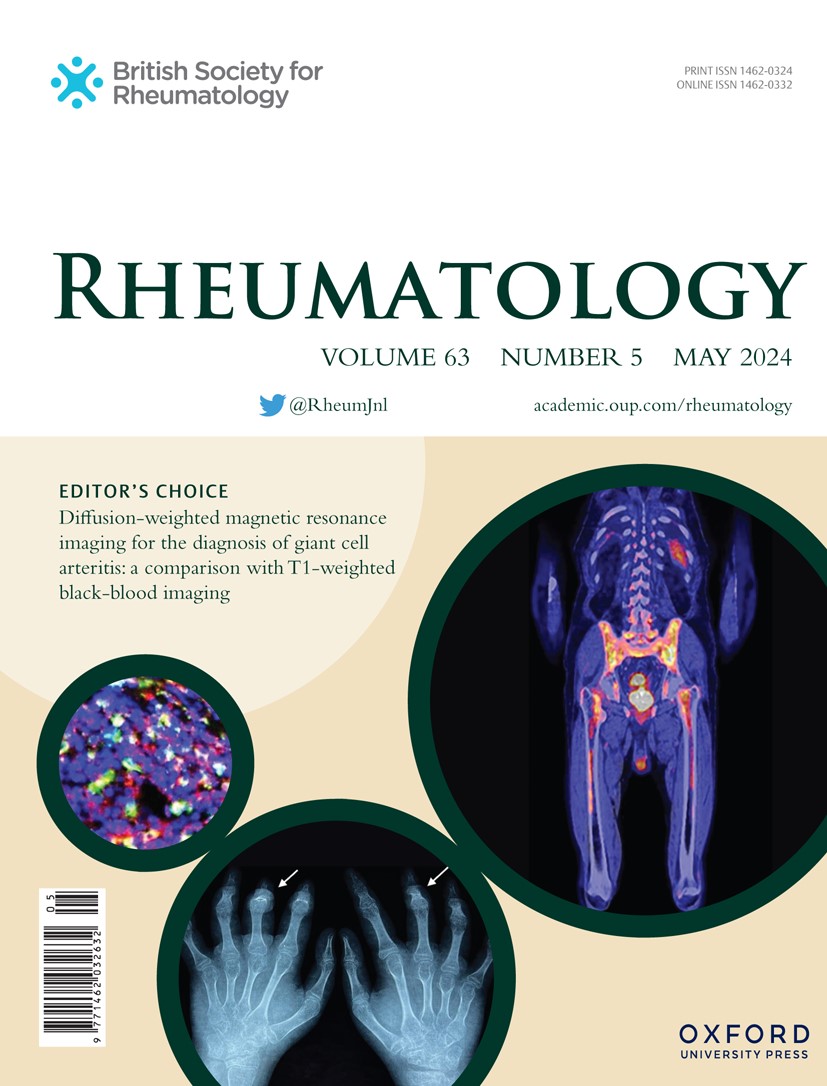接受靶向治疗的韩国类风湿关节炎患者缓解和生活质量预测布尔2.0标准的验证
IF 4.4
2区 医学
Q1 RHEUMATOLOGY
引用次数: 0
摘要
目的:在接受靶向治疗的韩国类风湿关节炎(RA)患者中,通过评估其与基于指数的缓解标准的一致性及其对生活质量(QoL)结果的预测效度,验证布尔2.0缓解定义中修订后的患者总体评估(PtGA)阈值2 cm的有效性。方法对一项多中心前瞻性队列研究数据进行分析,这些患者开始接受Janus激酶抑制剂或生物疾病改善抗风湿药物治疗。采用布尔1.0、布尔2.0和基于指数的标准评估缓解情况,包括28个关节的疾病活动评分,以红细胞沉降率(DAS28-ESR)、临床疾病活动指数(CDAI)和简化疾病活动指数(SDAI)计算。布尔定义和基于索引的标准之间的一致性使用科恩的kappa进行评估。通过比较第24周的缓解状态和第48周患者报告的结果来确定预测效度,特别是健康评估问卷-残疾指数(HAQ-DI)≤0.5和EuroQoL- 5维度(EQ-5D)=1。结果在506例入组患者中,414例完成了为期48周的随访。与布尔1.0相比,布尔2.0与DAS28-ESR缓解的一致性较强(κ = 0.50 vs 0.39),而与CDAI (κ = 0.75 vs 0.48)和SDAI (κ = 0.76 vs 0.64)的一致性较弱。与布尔2.0相比,布尔1.0对HAQ-DI≤0.5 (0.90 vs 0.82)和EQ-5D = 1 (0.38 vs 0.30)的阳性预测值更高。结论布尔值2.0虽然提高了DAS28-ESR的一致性,但并不能提高对长期功能和生活质量的预测。其更广泛的缓解定义在临床实践中值得谨慎解释。本文章由计算机程序翻译,如有差异,请以英文原文为准。
Validation of Boolean 2.0 criteria for remission and quality of life prediction in Korean patients with rheumatoid arthritis receiving targeted therapy.
OBJECTIVE
To validate the revised patient global assessment (PtGA) threshold of 2 cm in the Boolean 2.0 remission definition by assessing its agreement with index-based remission criteria and its predictive validity for quality of life (QoL) outcomes, compared with Boolean 1.0, in Korean patients with rheumatoid arthritis (RA) receiving targeted therapy.
METHODS
Data from a multicentre prospective cohort of patients with RA initiating treatment with Janus kinase inhibitors or biologic disease-modifying anti-rheumatic drugs were analysed. Remission was assessed using Boolean 1.0, Boolean 2.0, and index-based criteria including Disease Activity Score in 28 joints calculated with erythrocyte sedimentation rate (DAS28-ESR), Clinical Disease Activity Index (CDAI), and Simplified Disease Activity Index (SDAI). Agreement between Boolean definitions and index-based criteria was evaluated using Cohen's kappa. Predictive validity was determined by comparing remission status at week 24 and patient-reported outcomes at week 48, specifically Health Assessment Questionnaire-Disability Index (HAQ-DI) ≤0.5 and EuroQoL- 5 Dimension (EQ-5D)=1.
RESULTS
Among 506 enrolled patients, 414 completed the 48-week follow-up. Boolean 2.0 showed stronger agreement with DAS28-ESR remission than Boolean 1.0 (κ = 0.50 vs 0.39), but weaker agreement with CDAI (κ = 0.75 vs 0.48) and SDAI (κ = 0.76 vs 0.64). Boolean 1.0 demonstrated higher positive predictive values for HAQ-DI ≤0.5 (0.90 vs 0.82) and EQ-5D = 1 (0.38 vs 0.30) compared with Boolean 2.0.
CONCLUSION
Although Boolean 2.0 improves concordance with DAS28-ESR, it does not enhance the prediction of long-term functional or QoL outcomes. Its broader definition of remission warrants cautious interpretation in clinical practice.
求助全文
通过发布文献求助,成功后即可免费获取论文全文。
去求助
来源期刊

Rheumatology
医学-风湿病学
CiteScore
9.40
自引率
7.30%
发文量
1091
审稿时长
2 months
期刊介绍:
Rheumatology strives to support research and discovery by publishing the highest quality original scientific papers with a focus on basic, clinical and translational research. The journal’s subject areas cover a wide range of paediatric and adult rheumatological conditions from an international perspective. It is an official journal of the British Society for Rheumatology, published by Oxford University Press.
Rheumatology publishes original articles, reviews, editorials, guidelines, concise reports, meta-analyses, original case reports, clinical vignettes, letters and matters arising from published material. The journal takes pride in serving the global rheumatology community, with a focus on high societal impact in the form of podcasts, videos and extended social media presence, and utilizing metrics such as Altmetric. Keep up to date by following the journal on Twitter @RheumJnl.
 求助内容:
求助内容: 应助结果提醒方式:
应助结果提醒方式:


